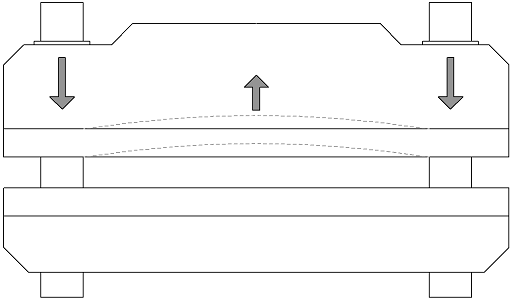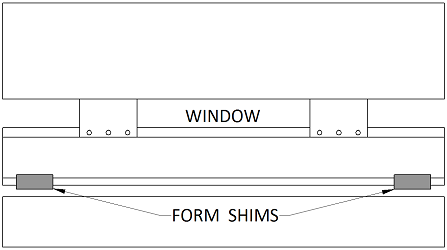Shimming
Proper
brake maintenance, cleaning of dies and careful alignment are key first
steps to ensuring accurate and reliable bending. However even after
taking the necessary precautions Bend Angles can still end up being
irregular across the length of the bend due to crowning or other
machine related flexing. The most common form of flexing that occurs
in a press brake is what is known as crowning. Crowning occurs when
the upper and lower beam, despite their often significant structure,
flex away from the work piece in the center of the brake. Most brakes
are driven by two points at either ends of the press. These points can
be the cams of a mechanical brake or the cylinders of a hydraulic
brake. The entire force of the brake is driven through these two
points, so the longer the beams, the more room for deflection. Below
shows a generic Brake Press
whose upper beam is undergoing crowning. Before using shims to recover
from the effects of crowning you should, if possible, bend your work
piece at the center of the brake. While this won’t eliminate the
crowning it will center it on your tooling, making it easier to
compensate for.

Once
the need for shimming has been established, and all other basic
assurances have been made that the machine is functioning properly, you
will begin to slowly add height to the areas where your Bend Angle
is large. The most effective method for shimming is removing the die
and placing a piece of paper under the area where you are looking to
shim. Depending on your v opening a single sheet of paper can add as
much as 1° to that area of the bend. The larger the v opening the more
shimming will be required to achieve this because the punch has to
travel further in order to affect the work piece. It is important to
stress this level of precision to new operators in order to prevent
dangerous over shimming on the first try.
Forming Shims
Another common situation which can be solved with shimming is the twisting of a Brake Press
when the tooling is off center. Many times a setup will call for
different sections of a Brake Press to be used to bend different parts
of a work piece. This typically involves moving the work piece from
one end to the other during the entire bending process. When the work
piece is at one end of the press it is going to unbalance the load at
the other end. This can at best force the machine to compensate with
hydraulics, and at worst cause a machine stop or failure. A Forming
Shim is a piece of the same material which, already bent, can be placed
inside the v opening at the far end of the brake, sometimes with the
addition of a paper shim, in order to balance the load at the bottom of
the bend. This type of shim can run the entire length of the Brake
Press is necessary in order to even out the load. Forming shims are
especially useful when Bottom Bending and Coining because the majority of the tonnage will be applied after the punch has made contact with the shim.

As
you can see above, a bend operation set up on the left end of the brake
causes uneven force to be applied, resulting in a twisting of the upper
beam. Even a single degree of rotation on the upper beam can be
significant to the operation of the press. In this operation adding a
forming shim to the right end of this brake would have prevented the
twisting from occurring.
Forming Shims are also commonly seen on Window Punching operations because they
help re-balance the load back into the center of the punch. The shims
are added to the punch area outside of the window. This adds a layer
of protection against crowning inside the window area.

Warning about Shimming
As
we discussed proper maintenance, calibration and cleaning of your Brake
Press will eliminate the majority of accuracy issues seen by operators
in day to day operations. Most modern brakes have methods of
compensating for crowning and twisting which, while not always perfect,
can be highly effective at reducing inaccuracies. Coatings on
materials, material tolerances, and stickers or labels added to parts
can all cause bends to change along the bend lines. While form
shimming is rather benign, adding a shim underneath your die should be
a last resort at correcting parts. Over time the tooling will begin to
wear in, adding an additional level of wear around the shim, resulting
in the need for more shimming. This can make the problem worse and
eventually end up ruining the die.
No comments:
Post a Comment